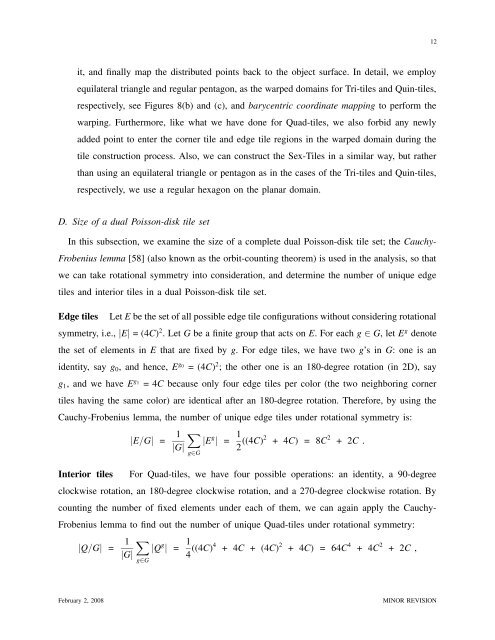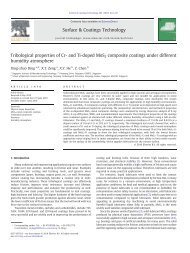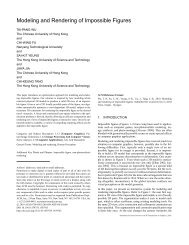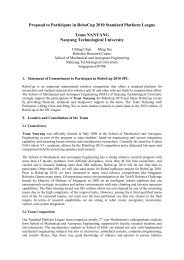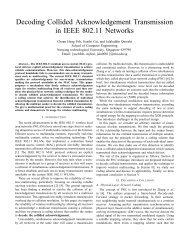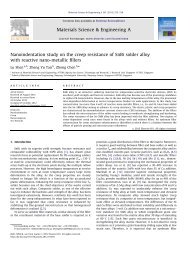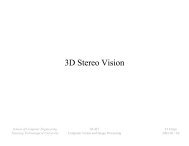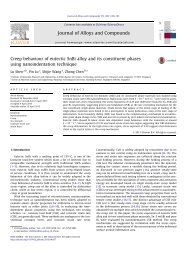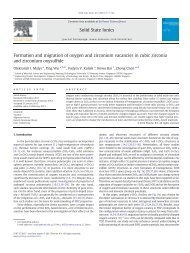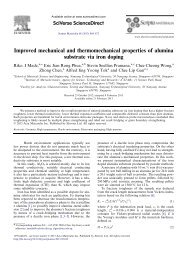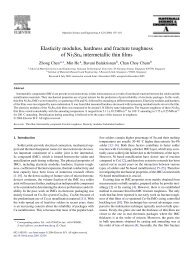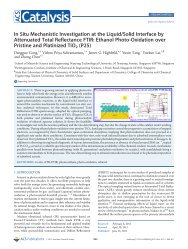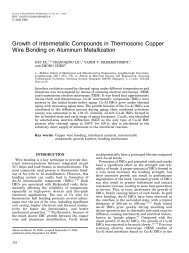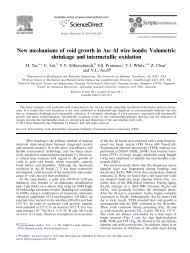ptdist - Nanyang Technological University
ptdist - Nanyang Technological University
ptdist - Nanyang Technological University
You also want an ePaper? Increase the reach of your titles
YUMPU automatically turns print PDFs into web optimized ePapers that Google loves.
it, and finally map the distributed points back to the object surface. In detail, we employ<br />
equilateral triangle and regular pentagon, as the warped domains for Tri-tiles and Quin-tiles,<br />
respectively, see Figures 8(b) and (c), and barycentric coordinate mapping to perform the<br />
warping. Furthermore, like what we have done for Quad-tiles, we also forbid any newly<br />
added point to enter the corner tile and edge tile regions in the warped domain during the<br />
tile construction process. Also, we can construct the Sex-Tiles in a similar way, but rather<br />
than using an equilateral triangle or pentagon as in the cases of the Tri-tiles and Quin-tiles,<br />
respectively, we use a regular hexagon on the planar domain.<br />
D. Size of a dual Poisson-disk tile set<br />
In this subsection, we examine the size of a complete dual Poisson-disk tile set; the Cauchy-<br />
Frobenius lemma [58] (also known as the orbit-counting theorem) is used in the analysis, so that<br />
we can take rotational symmetry into consideration, and determine the number of unique edge<br />
tiles and interior tiles in a dual Poisson-disk tile set.<br />
Edge tiles Let E be the set of all possible edge tile configurations without considering rotational<br />
symmetry, i.e., |E| = (4C) 2 . Let G be a finite group that acts on E. For each g ∈ G, let E g denote<br />
the set of elements in E that are fixed by g. For edge tiles, we have two g’s in G: one is an<br />
identity, say g0, and hence, E g0 = (4C) 2 ; the other one is an 180-degree rotation (in 2D), say<br />
g1, and we have E g1 = 4C because only four edge tiles per color (the two neighboring corner<br />
tiles having the same color) are identical after an 180-degree rotation. Therefore, by using the<br />
Cauchy-Frobenius lemma, the number of unique edge tiles under rotational symmetry is:<br />
|E/G| = 1<br />
|G|<br />
<br />
g∈G<br />
|E g | = 1<br />
2 ((4C)2 + 4C) = 8C 2 + 2C .<br />
Interior tiles For Quad-tiles, we have four possible operations: an identity, a 90-degree<br />
clockwise rotation, an 180-degree clockwise rotation, and a 270-degree clockwise rotation. By<br />
counting the number of fixed elements under each of them, we can again apply the Cauchy-<br />
Frobenius lemma to find out the number of unique Quad-tiles under rotational symmetry:<br />
|Q/G| = 1<br />
|G|<br />
<br />
g∈G<br />
|Q g | = 1<br />
4 ((4C)4 + 4C + (4C) 2 + 4C) = 64C 4 + 4C 2 + 2C ,<br />
February 2, 2008 MINOR REVISION<br />
12


